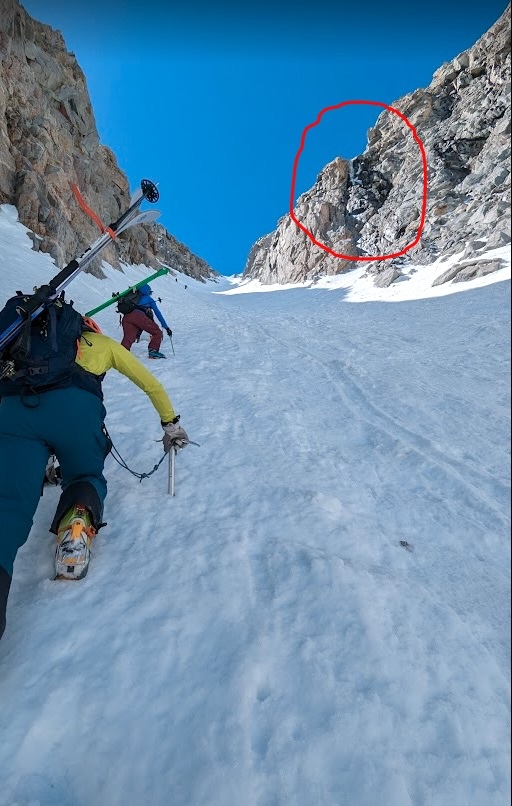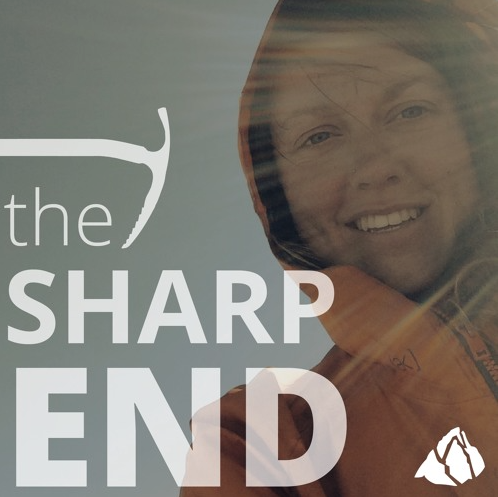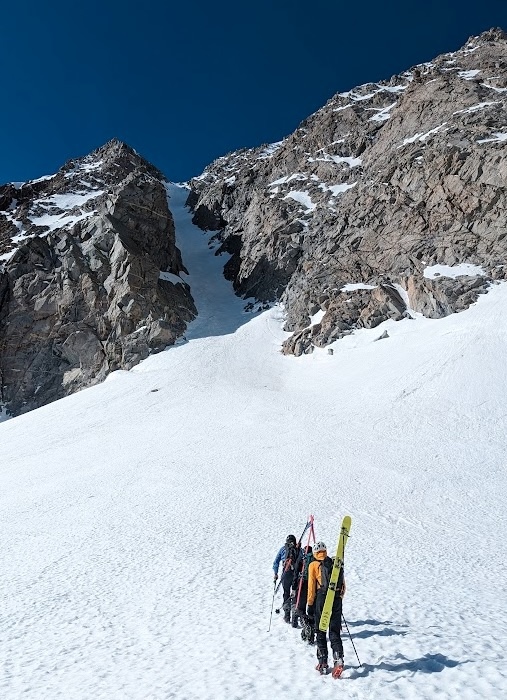Falling ice — Poor Position, Group Dynamics
California, Sierra Nevada, Mt. Emerson

Our party of four planned to ski the North Couloir on Mt. Emerson (13,210 feet), west of Bishop, on May 18. Two members of our party had skied in this area before, but not on Emerson specifically. The other two were visiting from out of state. Three of the four of us are volunteers on mountain rescue teams, and two are current or former licensed EMTs.
The weather was around 40°F at the Aspendell trailhead (8,400 feet) when we started at 5:30 a.m. The forecast was for clear skies and a high of 70°F at that elevation. Our objective topped out at around 13,000 feet, where we expected lower overnight temperatures and a cooler high.
We arrived at the base of the couloir around 9 a.m. and found a party of three just starting up. We followed shortly after them, starting our climb around 9:15 a.m. One member of the party ahead of us soon descended, and we caught up with the remaining two. Shortly after this, we were hit by falling ice chunks (up to softball sized), and we identified a frozen waterfall about 800 feet up the couloir, on climbers’ right, as the source. While the snow surface in the north-facing couloir was in the shade and quite firm, the waterfall was seeing its first sun at the top of the couloir’s wall.
We decided we would continue but if a similar incident happened we would bail. Communication of this decision within our party was imperfect due to group dynamics and being somewhat spread out across the couloir. After regrouping in a protected area on climbers’ left, we restarted as a team of four while the other party continued 100 to 200 feet above us. Person 1 (female, age 39) expressed hesitation in continuing, partly due to her perceived inability to maintain the pace set by the other climbers. Moving quickly and traveling together were emphasized as tactics for mitigating the overhead hazard.
Around 10 a.m., when we were about 50 feet below the waterfall, it shed more ice and hit our group directly. We estimate some of the ice chunks were microwave sized. None of the party members were knocked off their feet, but Person 1 was struck by ice in the head while she was in self-arrest position, as evidenced by a large dent on the top of her helmet. She was conscious but not alert and oriented, and incapable of climbing farther or descending on skis. She complained of light neck pain, moderate shoulder pain, and moderate hip pain. She was able to move and sense all extremities. Persons 2 and 3 also were struck in their heads, as evidenced by a laceration on Person 3’s ear and both helmets showing damage. Neither complained of significant pain or cognitive deficits.
The SOS feature on a Garmin inReach was activated. Persons 3 and 4 continued climbing to get above the hazard; they then transitioned to skis, and one person skied down the couloir to call 911. Meanwhile, Person 2 assisted Person 1 in downclimbing the couloir. Over the next 15 minutes, the injured member’s mental status was reassessed as alert and oriented (A&Ox4). She continued to complain of neck, shoulder, and hip pain, but the pain did not inhibit movement and no neurological deficits were observed.
Over the next 90 minutes, Persons 1 and 2 descended 800 feet to a safe zone on the apron below the couloir. The waterfall shed ice at least four times during this period, including once when large ice chunks fell down the couloir.
Inyo County SAR had initiated a call for helicopter resources but estimated they would not be in the area for a few hours and encouraged us to keep moving downhill if we were able. We made the decision to self-evacuate. We skied down the low-angle approach and reached the trailhead around 3 p.m.
At Northern Inyo Hospital, Person 1 was found to have a concussion and fractured C1 vertebra. She has made a full recovery. Person 3 needed stiches for a laceration on the back of her ear.
ANALYSIS
Ultimately, poor group dynamics led to the decision to continue climbing beneath a known hazard. Further, the group did not have enough experience with overhead ice hazard to fully assess the risk and appreciate how little “moving fast” mitigates that risk. Large chunks of falling ice would break up on the frozen snow of the couloir, which meant the potential for harm from large pieces of ice increased as the group climbed closer to the waterfall. The group had several opportunities to pause and discuss climbing strategy, pacing, and overall comfort with the objective, but failed to do that because of an overwhelming sense of urgency to move quickly.
Without observing this specific frozen waterfall frequently, it would not be possible to predict when it would melt and fall apart each day. We hypothesize the waterfall had been going through a diurnal freeze-thaw cycle, fed by a melting snowfield above. A much, much earlier start might have reduced the risk of being in a vulnerable climbing position during the bulk of the waterfall shedding. The sun hits the top of the couloir walls around 6 a.m. at that time of year.
After the incident, the group successfully executed a self-rescue. In hindsight, skiing down 3,000 vertical feet with a fractured C1 vertebra, in excellent weather and with plenty of time to wait for air rescue, was not a perfect decision. The team lacked knowledge of cervical spine mechanisms of injury, learning later that a significant axial load (large ice chunk to the head) followed by immediate neck pain (even minor pain) is indicative of possible fracture. The medical assessments in the field were thorough, but all parties were distracted by the dangerous and stressful situation of falling ice in the couloir. The team’s medical training and experience in rescue led to the decision to very quickly self-extricate from the couloir to avoid further injury. (Source: Person 1.)


